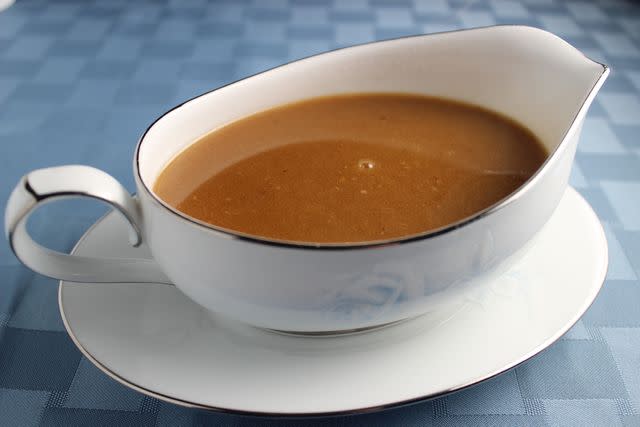Can You Freeze Gravy?
Learn how to extend the shelf life of this beloved pan sauce.

You might be tempted to think, “who in the world has extra gravy?” A prized pour for mashed potatoes, biscuits, sliced meats, and more, no one skimps on the sauce.
The need to freeze can arise from more than just leftovers, however. Sometimes it’s a matter of turning would-be waste into delicious future dinners. For example, a roasted chicken made for a dish that needs no gravy (to be shredded for a salad, perhaps) still yields drippings. Those drippings could be tossed out or turned into a gravy and frozen for an upcoming impromptu pot pie, simmered meatball dinner, or even chicken-fried steak.
Related: Our 15 Most Gravy-Rich Recipes
With gravy only lasting in the fridge for three to four days, freezing is the perfect solution to extending the life of your precious pan sauce.
What Is Gravy Made Of?
Gravy is quite possibly the ultimate comfort food – it's like a warm hug in savory sauce form. It’s also a way to rescue the flavor-packed drippings that come from cooking meat from going to waste. You can make a quick gravy by simply adding flour to the drippings and whisking, but for added flavor (or a larger amount of gravy), a broth that matches whatever meat was cooked (chicken broth for chicken or turkey, beef stock for beef), cream, milk, butter, and/or spices can be added as well. For our gluten-free friends, swap flour for a smaller amount of cornstarch.
Related: What Is Red Eye Gravy?
How to Freeze Gravy
Gravy made with any dairy isn’t the right candidate for freezing. Did you throw in milk, cream, or butter? Treat yourself to an extra ladle. Besides developing an unpleasant rough and grainy texture, it’s apt to separate after freezing and will never regain its former glory.
Like all liquid exposed to frigid temps, gravy will freeze solid. You just need to cool it completely first. Then it can be ladled into air-tight containers, freezer bags, or ice cube trays. Finally, don’t refreeze gravy after you’ve thawed it. This is a one and done situation.

Get the recipe: Make-Ahead Turkey Gravy
How Long Can Gravy Freeze For?
Gravy will hold up in the freezer for three to six months without taking a hit to its quality. Flour-based gravies may only good for three or four months.
How to Thaw and Use Frozen Gravy
The best way to use your frozen gravy is to let it thaw in the fridge overnight, then heat it slowly in a saucepan, whisking to get rid of lumps. You can add some water if it’s too thick or if it separated a bit - some liquid and a lively whisking can do a lot to help a broken gravy. Make sure the gravy reaches 165F before serving it.
If you’re pressed for time, thaw the gravy in a bowl of cold water like you would frozen meat, or in the microwave in 30-second intervals using the defrost setting.
Meats that the gravy might be served with, if also leftover, do well being frozen along with it/in it, since the gravy will fight the drying-out process. Reheat the meat along with the gravy in the oven at 350 degrees F. it reaches an internal temp of 160F. These combo plates last about 3 months in the freezer.
Frozen gravy or gravy ice cubes are perfect for assembling pot pies, casseroles, or other meat pies, adding to a soup or stew, or ladled over biscuits. Larger amounts of frozen gravy should be used for simmering something like meatballs for a saucy main course.
Related:

